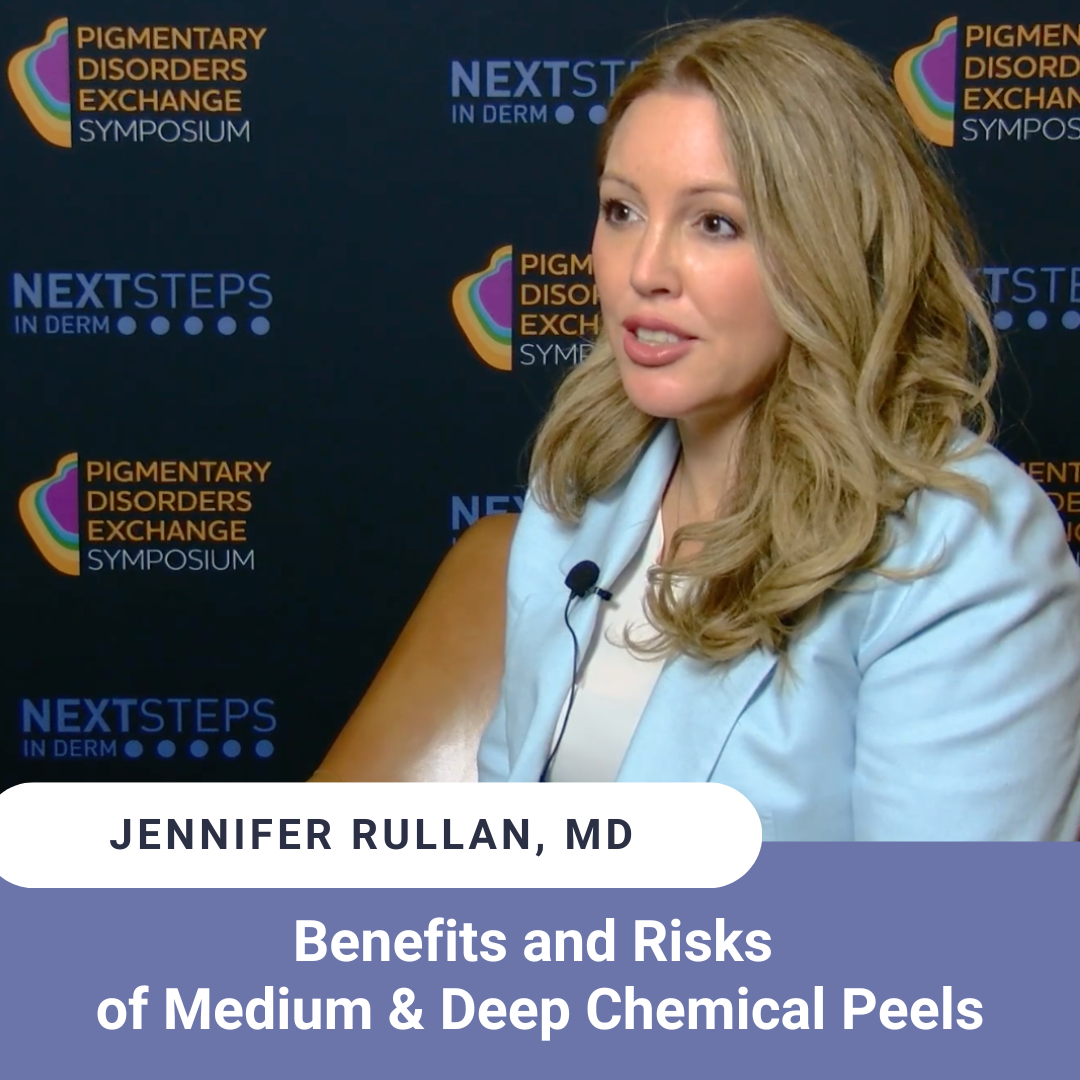Next Steps in Derm, in partnership with Pigmentary Disorders Exchange Symposium (PDE) interviewed Dr. Jennifer Rullan, a dermatologist in Chula Vista, Calif. Watch as Dr. Rullan outlines unexpected ingredients that dermatologists can use in medium depth and deep chemical peels to treat pigmentary disorders, and it may not be the disorders that you expect. Vitiligo? Idiopathic guttate hypomelanosis? Constitutional periorbital darkening? Dr. Rullan says chemical peels are an effective and easy way for dermatologists to treat these conditions.
Further Reading
If you want to read more about chemical peels, check out the following articles published in the Journal of Drugs in Dermatology:
ABSTRACT
Dyschromia is one of the primary complaints for patients with skin of color. Treatments need to achieve a balance between tolerability and efficacy to address existing hyperpigmentation without causing additional damage that could trigger post-inflammatory hyperpigmentation (PIH). An open-label, single-center study was conducted to assess the efficacy of a novel comprehensive pigmentation control serum (LYT2) combined with a series of three very superficial chemical peels (VP) in skin of color subjects. Seventeen female and male subjects aged 36 to 69 years with Fitzpatrick Skin Types III-VI and moderate to severe facial hyperpigmentation were enrolled in the 12-week clinical study. Subjects identified as Asian, Hispanic, African American, or Caucasian ethnicities. Subjects received a series of 3 VP treatments every 4 weeks. LYT2 was applied twice-daily in between VP treatments. Investigator assessments for overall hyperpigmentation, overall photodamage, and skin tone unevenness, as well as standardized digital photography and subject self-assessment questionnaires were conducted at all visits (baseline and weeks 4, 8, and 12). In vivo reflectance confocal microscopy (RCM) of a target lesion was conducted (in a subset of subjects) at baseline and week 12. Fourteen subjects completed the study. The treatment regimen provided statistically significant improvements in all efficacy parameters at weeks 8 and 12 (all P less than equal to 0.03, students t-test). Standardized digital photography and RCM images support the improvements in overall hyperpigmentation observed by the investigator. At the end of treatment, the regimen was highly rated by subjects with 100% of subjects (strongly agree/agree) that the combination decreased the appearance of uneven skin tone and discolorations and reduced the appearance of sun damage. In addition to this clinical study, independent case studies with this combination treatment regimen at a separate study site were also conducted with results that corroborate the formal clinical study findings. The comprehensive results from these studies suggest that the combination of a comprehensive pigmentation control serum with a series of 3 very superficial chemical peels may provide an effective treatment approach for hyperpigmentation in skin of color patients.
Melasma is an irregular brownish pigmentation observed on the faces of young to middle-aged women, especially of Asian races, which may contribute to various emotional disturbances. Although not any favorable treatment being approved yet, one appropriate approach is peeling by glycolic acid 70% (GA 70%). Considering the efficiency of Tretinoin in lower concentrations as over-the-counter lightening agents, peelings with higher strength Tretinoin may effectively relieve the pigmentation (melasma) sooner than other topical therapies.
Objective: The main purpose was to compare the efficiency and complications of GA 70% with Tretinoin 1% peeling.
Methods: A randomized, double-blinded clinical trial performed on 63 female patients with bilateral melasma. One facial side was treated by drug A (GA 70%) and the opposite side by agent B (Tretinoin 1%) peeling for four sessions with 2-week intervals. Descending changes in Melasma Area and Severity Index (MASI) scores, patients’ discomfort and untoward complications following peeling all were evaluated and compared during the research period.
Results: The efficiency of Tretinoin 1% peelings in declining the MASI score (treatment of melasma) was similar to GA 70%, as well as the rare unwanted complications of them. However, the patients’ discomfort following procedures as expressed by their own, was significantly lower with Tretinoin 1% compared to GA 70% peeling. The cases’ satisfaction with the intervention was statistically similar to each other. Furthermore, we experienced almost the equal times of beginning the therapeutic responses in both groups.
Did you enjoy this video interview? Find more here.
CATEGORIESDERM TOPICS, VIDEO PEARLS
TAGS JENNIFER RULLAN, MD, FAAD; CHEMICAL PEELS; VITILIGO; PIGMENTARY DISORDERS; HYPERPIGMENTATION; MELASMA

